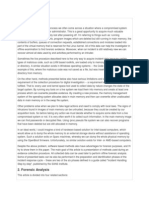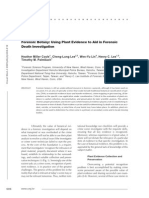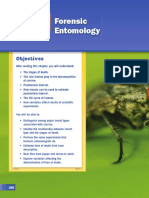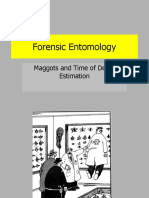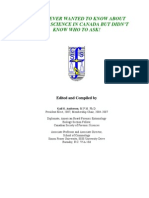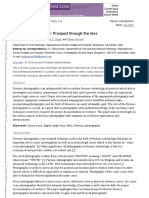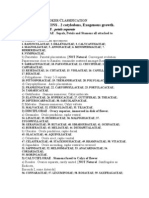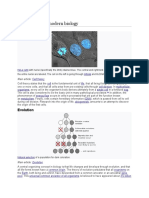Significance of Wildlife Forensics and Endangered Species of Plants, Animals and Reptiles
Significance of Wildlife Forensics and Endangered Species of Plants, Animals and Reptiles
Uploaded by
Niranjana KarandikarCopyright:
Available Formats
Significance of Wildlife Forensics and Endangered Species of Plants, Animals and Reptiles
Significance of Wildlife Forensics and Endangered Species of Plants, Animals and Reptiles
Uploaded by
Niranjana KarandikarOriginal Description:
Original Title
Copyright
Available Formats
Share this document
Did you find this document useful?
Is this content inappropriate?
Copyright:
Available Formats
Significance of Wildlife Forensics and Endangered Species of Plants, Animals and Reptiles
Significance of Wildlife Forensics and Endangered Species of Plants, Animals and Reptiles
Uploaded by
Niranjana KarandikarCopyright:
Available Formats
MSc 1
Roll No.12
Significance Of Wildlife Forensics and Endangered Species of Plants, Animals and Reptiles
Wildlife forensics is the application of a range of scientific disciplines to legal cases involving non-human biological evidence. These disciplines include genetics, morphology, chemistry, pathology, and veterinary sciences. Significance of Wildlife Forensics: Food: e.g., caviar from Caspian Sea sturgeon, freshwater and marine turtles; Pets: many species of exotic amphibians, reptiles and birds; Testing to distinguish extant elephant and mammoth ivory products Species identification of cetaceans (dolphin/whale) illegally killed Species determination of birds from eggs Timber: rainforest hardwood trees such as mahogany and teak; Analysis of ivory roulette balls to establish whether they are made of ivory Testing traditional medicine: e.g., rhinoceros horns, bear gallbladders, and various plants in TAM(Traditional Asian Medicine). Animal furs and skins: e.g., the trade in crocodile and alligator skins; and products sold as souvenirs such as figurines made from illegal ivory or marine turtle shells, or jewellery made of coral.
Wildlife forensics also has a role in the following: -Species identification Detailed species identification techniques have been established for the following: -Whales and dolphins -Commercial kangaroo meat industry -Identification of bird species for -Snakes/Lizard -Pigs -Camels -Possums -Illegal seizure work with CALM/AQIS/Customs etc -Identification of birdstrike species (birds colliding with aeroplanes) The approach is possible because animals (and plants) inherit the traits determined by mitochondrial DNA (mtDNA) from the maternal line. These characteristics, therefore, do
Niranjana .S. Karandikar Page 1
MSc 1
Roll No.12
not in principle differ between mother and offspring and are used (because there is no recombination of the DNA during sexual segregation), among other things, to determine genetic relations between species. -Population identification To computate the number of animals of a particular species by methods such as pugmark analysis. Like fingerprints the pug marks also are unique to each and every animal belonging to the same species -Identification of mixed animal tissue In cases of poaching and trafficking the original animal tissues and other material is often mixed with the flesh of animals which are permitted and is later separated after the smuggling is done. -Sex identification Difficulty with sex identification is a frequently encountered problem in various fields of forensics, animal biology and medicine because conventional methods require special skill for sample preparation and identification (e.g decomposition, sexes are monomorphic, no physical evidence or cytological investigation). Recent advances of DNA analysing techniques has considerably hastened up the procedure. A rapid and straightforward method of sex identification from the DNA in a trace amount of saliva and from bird feathers using PCR is possible. Preparation of DNA using chelex based extraction requires only a short time. To identify particular alleles, samples must be run on high resolution gels along with an "allelic ladder" containing a range of the known alleles of known size. Minute amounts of cells (feather end etc) are collected by centrifugation and heated in a buffered solution containing beads of the resin Chelex. Lysis of the cells and release of DNA is accomplished by a boiling water bath and the alkalinity of the Chelex suspension. PCR is then performed with the DNA-containing supernatant. Endangered species of Plants, Animals and Reptiles What are Endangered species? An endangered species is a native species that faces a significant risk of extinction in the near future throughout all or a significant portion of its range. Such species may be declining in number due to threats such as habitat destruction, climate change, or pressure from invasive species. The term endangered species can be used either in general or legal context. When used in a general sense, the term describes a species that faces a risk of extinction but does not necessarily indicate that the species is protected under any law. When used in a legal context, the term refers specifically to a species that is listed on the US Endangered Species List and is defined legally as an animal or plant species in danger of extinction throughout all or a significant portion of its range.
Niranjana .S. Karandikar
Page 2
MSc 1
Roll No.12
CITES (the Convention on International Trade in Endangered Species of Wild Fauna and Flora) is an international agreement between governments. Its aim is to ensure that international trade in specimens of wild animals and plants does not threaten their survival. Endangered species are protected by more than just the Wildlife Protection Act. Local laws, enforced by state governments and state Departments of Natural resources protect species in the country. Groups of species are protected by specific acts such as the Wildlife Protection Act. Many foreign countries have laws protecting their endangered species. Endangered species are protected on international levels as well. For example, the Convention on International Trade in Endangered Species of Wild Fauna and Flora (CITES) is an agreement between150 countries worldwide. Endangered species are listed under one of two appendices of CITES .If a species is listed under Appendix I, the member countries have agreed not to trade (buy and sell) that species commercially. If a species is listed under Appendix II, the member countries have agreed to trade that species commercially only if it does not endanger the survival of the species. The following are some of the endangered species which are listed by CITES & WWF : Plants: 1.Baobob Tree (Adansonia gregorii) Native to equatorial Africa and India, and most famous for covering much of Madagascar, the distinctive baobob tree is increasingly threatened. This tree is leafless nine months of the year and stores water in its trunk much like a camel. People make homes in the base, and the tree also produces an edible fruit called the monkeyfruit. 2.Cork(Quercus suber) The cork is actually a type of oak. From this article on endangered forests: The odd and distinctive cork bark forest of the Mediterranean is a case where industry actually preserves this unique biome. In fact, the advent of the screw-top wine stopper is the cork bark forests greatest threat. Experts say we will lose cork forests in the next decade if the wine industry continues to turn to alternative corks. Cork oaks can be shorn, much like sheep, for many years with proper maintenance. Without market incentive, though, these forests may fall into disrepair or be cleared all together. 3.Rafflesia The rafflesia is a parasitic plant with a flesh-like bloom the size of an armchair and a stench thats unmissable if youre even remotely close. 4.Tacca Chantrieri The black bat flower, or tacca chantrieri, is exceptionally rare and quite beautiful. The flowers can reach over 12 in diameter and each bloom typically has many whiskers that can grow to two feet or more in length.
Niranjana .S. Karandikar
Page 3
MSc 1
Roll No.12
5. Polygala irregularis Gujarat(rare)commonly known as Milkwort is an annual or perennial herb.Blooms during July and August.The plants are found at an altitude of 1000 meters.The flowers are found in blue ,near white ,pink and white in color.The plants are destroyed due to human habitation and land for agriculture. 6. Diospyros celibica Karnataka(threatened)Ebony tree -It is a flowering tree and considered highly by woodworkers as they are widely used for making high quality furniture.The trees can grow up to 20 metres height under favourable conditions..But in the past two centuries it has become a very scarce and hardly found in India. 7. Actinodaphne lawsonii Kerala(threatened)it belongs to lauraceae family .It is endemic and it is threatened by habitat loss.It is canopy or sub canopy trees found in high elevation evergreen forest between 1200 to 2400 meters.The leaves are aromatic and has medicinal use. 8. Acacia planifrons Tamilnadu (rare)(umbrella thorn)they grow as a shrub or a short tree.In tamil they are called kudai vel,the tree is used as a fuel and fodder for sheep and goats. When the tree is fully grown it appears as a spreaded umbrella. 9.Abutilon indicum Tamilnadu(rare)commonly known as indian mallow is a small shrub in Malvaceae family.it is used as medicinal plant and they occur in number of tropical and subtropical zones.The plant was much used in sidda medicine.The root,bark,flowers and leaves are all used for medicinal purposes.It is called thuthi in tamil athibalaa in Sanskrit. 10.Chlorophytum tuberosum Tamilnadu it is a endangered plantis also called musli.It is a flowering plant native to Africa and India.It has historical uses in Ayurveda commonly used for strength and vigour.The plant belongs to Liliaceae family.
Niranjana .S. Karandikar
Page 4
MSc 1
Roll No.12
Animals:
The following are top 10 endangered species of Animals and reptiles as listed by World Wildlife Fund(WWF) Sr No Common Name 1 Amur Leopard 2 Black Rhino Cross River 3 Gorilla 4 Hawksbill Turtle 5 Javan Rhino Leatherback 6 Turtle 7 Mountain Gorilla 8 Saola South China 9 Tiger Sumatran 10 Elephant Scientific Name Panthera pardus orientalis Diceros bicornis Gorilla gorilla diehli Eretmochelys imbricata Rhinoceros sondaicus Dermochelys coriacea Gorilla beringei beringei Pseudoryx nghetinhensis Panthera tigris amoyensis Elephas maximus sumatranus Status Critically Endangered Critically Endangered Critically Endangered Critically Endangered Critically Endangered Critically Endangered Critically Endangered Critically Endangered Critically Endangered Critically Endangered
Niranjana .S. Karandikar
Page 5
MSc 1
Roll No.12
References: http://www.wildlifeforensics.com.au/background_info.html
http://en.wikipedia.org/wiki/Wildlife_forensic_science
https://worldwildlife.org/species/directory?direction=desc&sort=extinction_status http://webecoist.momtastic.com/2008/11/03/strange-rare-bizarre-endangered-flowers-plantsand-trees/
Niranjana .S. Karandikar
Page 6
You might also like
- Cambridge IGCSE Biology 3rd Edition PDFDocument401 pagesCambridge IGCSE Biology 3rd Edition PDFSylvia Nyakujawa86% (28)
- Forensic BotanyDocument346 pagesForensic BotanyHebertneves0% (1)
- Cambodian Tree SpeciesDocument61 pagesCambodian Tree Speciesfredericodalmeida33% (3)
- Time Since Death and Decomposition of The Human Body: Variables and Observations in Case and Experimental Field StudiesDocument9 pagesTime Since Death and Decomposition of The Human Body: Variables and Observations in Case and Experimental Field StudiesIvana KaraćNo ratings yet
- Determination of Age of DocumentDocument5 pagesDetermination of Age of DocumentNiranjana Karandikar100% (3)
- Determination of Age of DocumentDocument5 pagesDetermination of Age of DocumentNiranjana Karandikar100% (3)
- Lesson Plan For Demo TeachingDocument6 pagesLesson Plan For Demo Teachingjanice alquizar100% (6)
- AP Lab 3: Comparing DNA Sequences To Understand Evolutionary Relationships With BLASTDocument11 pagesAP Lab 3: Comparing DNA Sequences To Understand Evolutionary Relationships With BLASTZurab BasilashviliNo ratings yet
- Forensic Pathology Role of The Medical Examiner PPTDocument85 pagesForensic Pathology Role of The Medical Examiner PPTMubashiryyy mehmood50% (2)
- Evidence Collection 6Document74 pagesEvidence Collection 6Derrick100% (1)
- Forensic PathologyDocument833 pagesForensic PathologyRahma Nasir100% (1)
- Collection of Volatile Data (Linux)Document7 pagesCollection of Volatile Data (Linux)Niranjana Karandikar100% (1)
- Significance of Wildlife Forensics and Endangered Species of Plants, Animals and ReptilesDocument26 pagesSignificance of Wildlife Forensics and Endangered Species of Plants, Animals and ReptilesNiranjana Karandikar100% (1)
- Ballistic Trauma in Veterinary Forensic PathologyDocument2 pagesBallistic Trauma in Veterinary Forensic PathologyEdwardNo ratings yet
- Wildlife Forensic: Current Techniques and Their Limitations: J Forensic Sci Criminol 5 (4) : 402Document6 pagesWildlife Forensic: Current Techniques and Their Limitations: J Forensic Sci Criminol 5 (4) : 402Aashima OhriNo ratings yet
- Week 1Document5 pagesWeek 1Ashley Castro100% (1)
- Forensic BotanyDocument15 pagesForensic BotanySadiyah Qamar0% (1)
- Forensic EntomologyDocument48 pagesForensic EntomologyAdnan Qureshi100% (1)
- Forensic Botany An Emerging Discipline of Plant SciencesDocument8 pagesForensic Botany An Emerging Discipline of Plant SciencesJoseNo ratings yet
- Forensic EntomologyDocument8 pagesForensic Entomologyjuankdv100% (1)
- Forensic Human Hair Examination GuidelinesDocument32 pagesForensic Human Hair Examination GuidelinessbspuNo ratings yet
- Wildlife Forensics: Investigation Techniques & Laws in IndiaDocument29 pagesWildlife Forensics: Investigation Techniques & Laws in Indiaprasanth chintaNo ratings yet
- EntomologyDocument37 pagesEntomologytariNo ratings yet
- Forensic Entomology (HOSA)Document33 pagesForensic Entomology (HOSA)Alex0% (1)
- Anthropology Taphonomy EntomologyDocument108 pagesAnthropology Taphonomy EntomologyAya ChouaibNo ratings yet
- Forensic Entomology Applications Case ReportsDocument9 pagesForensic Entomology Applications Case ReportsDickyNo ratings yet
- Use of Insects in Forensic ScienceDocument3 pagesUse of Insects in Forensic ScienceEmanuel Ruiz RodriguezNo ratings yet
- Blood Stain Pattern AnalysisDocument45 pagesBlood Stain Pattern AnalysiselashmawyhagerNo ratings yet
- Insect Evidence: Basic Collection Procedures at the Death SceneFrom EverandInsect Evidence: Basic Collection Procedures at the Death SceneNo ratings yet
- Forensic Batany Using Plants Evidence To Aid in Forensic Death InvestigationDocument7 pagesForensic Batany Using Plants Evidence To Aid in Forensic Death InvestigationMinnie FarfanNo ratings yet
- Plant EvidenceDocument51 pagesPlant EvidencejackassjoeyNo ratings yet
- 2010 MG EntomologyDocument11 pages2010 MG EntomologyhundohanNo ratings yet
- Which Technique Is Best For Evisceration During Autopsy ?Document24 pagesWhich Technique Is Best For Evisceration During Autopsy ?Dr.Shrabana Kumar Naik100% (2)
- Medico Legal AutopsyDocument5 pagesMedico Legal AutopsyIzny SyeeraNo ratings yet
- Forensics TextDocument24 pagesForensics Textapi-32133818No ratings yet
- CH 13 Forensic EntomologyDocument40 pagesCH 13 Forensic EntomologyAnonymous AzXah9n0YNo ratings yet
- Fundamentals of Forensic BiologyDocument539 pagesFundamentals of Forensic Biologyjournee97No ratings yet
- Examination of Blood StainsDocument54 pagesExamination of Blood Stainsiram khanNo ratings yet
- Writing in Forensic ScienceDocument10 pagesWriting in Forensic Scienceapi-284393070100% (2)
- ForensicSerology (Student Version)Document19 pagesForensicSerology (Student Version)Normalyn Andres MacaysaNo ratings yet
- Leg Med Report On Forensic EntomologyDocument31 pagesLeg Med Report On Forensic EntomologyYannie BarcelonaNo ratings yet
- Introduction To Forensic Science Forensic EntomologyDocument48 pagesIntroduction To Forensic Science Forensic EntomologyChris Sheehan100% (1)
- Top 10 Plants Poisonous To Pets Pet Poison HelplineDocument2 pagesTop 10 Plants Poisonous To Pets Pet Poison HelplineCatalina DobreNo ratings yet
- Forensic Anthropology and OdontologyDocument27 pagesForensic Anthropology and OdontologyAditya100% (1)
- Importance/value of Legal Medicine inDocument13 pagesImportance/value of Legal Medicine inGenevieve TersolNo ratings yet
- Toxicity of ToadsDocument29 pagesToxicity of ToadsAdarshBijapurNo ratings yet
- Forensic Laboratory Science ModuleDocument5 pagesForensic Laboratory Science ModuleJayson B. SanchezNo ratings yet
- HPLCDocument4 pagesHPLCLuis Siller AlmazanNo ratings yet
- Forensic BiologyDocument2 pagesForensic BiologyTannelsNo ratings yet
- Pathology Findings For San Luis Obispo County Deaths - April 2015 - March 2018Document6 pagesPathology Findings For San Luis Obispo County Deaths - April 2015 - March 2018mattNo ratings yet
- Ethics in Forensic ScienceDocument10 pagesEthics in Forensic Scienceapi-218687995100% (1)
- Maggots and MurdersDocument5 pagesMaggots and MurdersElenaNo ratings yet
- Bloodspatter AnalysisDocument56 pagesBloodspatter AnalysisMalik HammadNo ratings yet
- Forensic Mycology - The Use of Fungi in Criminal Investigations.Document11 pagesForensic Mycology - The Use of Fungi in Criminal Investigations.Carlos MolinaNo ratings yet
- Intro To Forensic ScienceDocument9 pagesIntro To Forensic SciencePeachy Pie67% (3)
- The Human Skeleton: Anterior ViewDocument3 pagesThe Human Skeleton: Anterior Viewluz marina chacon zamoraNo ratings yet
- Forensic Science BookletDocument76 pagesForensic Science Bookletn3xtnetwork100% (3)
- Chapter 16 Forensic EntomologyDocument11 pagesChapter 16 Forensic EntomologyYanna Rizkia100% (1)
- Final Special Crime Investigation With Legal Medicine ReviewDocument203 pagesFinal Special Crime Investigation With Legal Medicine ReviewRaquel IgnacioNo ratings yet
- Forensic Photography Part 1Document62 pagesForensic Photography Part 1Shy OreoNo ratings yet
- Questioned Ducument Chapter Leg 2 2021 ModuleDocument5 pagesQuestioned Ducument Chapter Leg 2 2021 ModuleLayug Lorence JadeNo ratings yet
- Forensic EntomologyDocument16 pagesForensic Entomologyὑδράργυρος ὕδωρNo ratings yet
- Forensic Photography: Prospect Through The LensDocument6 pagesForensic Photography: Prospect Through The LenszakiyaNo ratings yet
- Forensic SerologyDocument46 pagesForensic SerologyYosi W KusumaNo ratings yet
- Postmortem Changes and Postmortem Time IntervalDocument24 pagesPostmortem Changes and Postmortem Time IntervalkhadzxNo ratings yet
- Endangered Species ColoringDocument33 pagesEndangered Species ColoringvjramsieNo ratings yet
- Backup ObstaclesDocument1 pageBackup ObstaclesNiranjana KarandikarNo ratings yet
- Cyber Forensics Field Manual, Second EditionDocument1 pageCyber Forensics Field Manual, Second EditionNiranjana Karandikar100% (1)
- EnumerationDocument12 pagesEnumerationNiranjana KarandikarNo ratings yet
- Biometric Technologies and Verification Systems by John R VaccaDocument1 pageBiometric Technologies and Verification Systems by John R VaccaNiranjana KarandikarNo ratings yet
- Unlimited Plan: 1 Domains HostingDocument1 pageUnlimited Plan: 1 Domains HostingNiranjana KarandikarNo ratings yet
- Certified Ethical Hacker v8 - Study GuideDocument146 pagesCertified Ethical Hacker v8 - Study GuideWayan Sriyasa100% (2)
- Arp PoisoningDocument17 pagesArp PoisoningNiranjana KarandikarNo ratings yet
- Virtualization Standards and ComplianceDocument19 pagesVirtualization Standards and ComplianceNiranjana KarandikarNo ratings yet
- FTKManualDocument348 pagesFTKManualNiranjana Karandikar100% (1)
- Response To A Live Linux MachineDocument13 pagesResponse To A Live Linux MachineNiranjana KarandikarNo ratings yet
- Enumeration: MSC 2 Sem 3 Paper 1Document13 pagesEnumeration: MSC 2 Sem 3 Paper 1Niranjana KarandikarNo ratings yet
- Network Architecture Fundamentals: Niranjana.S.KarandikarDocument37 pagesNetwork Architecture Fundamentals: Niranjana.S.KarandikarNiranjana KarandikarNo ratings yet
- Building MaterialsDocument5 pagesBuilding MaterialsNiranjana Karandikar100% (1)
- Converting Scene Data Into Event SequenceDocument5 pagesConverting Scene Data Into Event SequenceNiranjana KarandikarNo ratings yet
- Building MaterialsDocument5 pagesBuilding MaterialsNiranjana Karandikar100% (1)
- Bentham N Hooker ClassificationDocument4 pagesBentham N Hooker ClassificationNiranjana KarandikarNo ratings yet
- Establishing The Chain of CustodyDocument2 pagesEstablishing The Chain of CustodyNiranjana KarandikarNo ratings yet
- Chromatography Chromatography Is A Physical Method of Separation in Which The Components To Be SeparatedDocument2 pagesChromatography Chromatography Is A Physical Method of Separation in Which The Components To Be SeparatedNiranjana KarandikarNo ratings yet
- Question Bank For F Y B.SC Forensic Science Paper 1: Advanced Forensic Science Second Term ExaminationDocument3 pagesQuestion Bank For F Y B.SC Forensic Science Paper 1: Advanced Forensic Science Second Term ExaminationNiranjana KarandikarNo ratings yet
- Animal Week TriptychDocument2 pagesAnimal Week TriptychScribdTranslationsNo ratings yet
- Endangered SpeciesDocument17 pagesEndangered SpeciesMrithika VNo ratings yet
- Dna Barcoding As A Tool For Sustainable Harvesting of Medicinal Plants Used in The Treatment of Diarrhoea and Male Sexual Weakness in GhanaDocument112 pagesDna Barcoding As A Tool For Sustainable Harvesting of Medicinal Plants Used in The Treatment of Diarrhoea and Male Sexual Weakness in GhanaAmine ChradiNo ratings yet
- (SpringerBriefs in Biology) Noboru Okuda, Katsutoshi Watanabe, Kayoko Fukumori, Shin-ichi Nakano, Takefumi Nakazawa (auth.) - Biodiversity in Aquatic Systems and Environments_ Lake Biwa-Springer Japan.pdfDocument99 pages(SpringerBriefs in Biology) Noboru Okuda, Katsutoshi Watanabe, Kayoko Fukumori, Shin-ichi Nakano, Takefumi Nakazawa (auth.) - Biodiversity in Aquatic Systems and Environments_ Lake Biwa-Springer Japan.pdfnabillaNo ratings yet
- The Botanical Review 1970 v36Document71 pagesThe Botanical Review 1970 v36alborewimi09No ratings yet
- Foundations of Modern BiologyDocument4 pagesFoundations of Modern BiologyJohn Kenneth Escober BentirNo ratings yet
- Kebo 101Document15 pagesKebo 101Devansh DhawanNo ratings yet
- Descent With ModificationDocument4 pagesDescent With ModificationblablaNo ratings yet
- Evolution and Origin of BiodiversityDocument37 pagesEvolution and Origin of BiodiversityRochelle MendozaNo ratings yet
- BEEd 2A Biodiversity Evolution 1Document8 pagesBEEd 2A Biodiversity Evolution 1razzelngpinasNo ratings yet
- Behavioural and Ecological Consequences of Urban Life in BirdsDocument364 pagesBehavioural and Ecological Consequences of Urban Life in BirdsYan TrovatoNo ratings yet
- More Evolution Review FRQDocument2 pagesMore Evolution Review FRQPranali Shah AroraNo ratings yet
- A Photographic Guide To Macro-Moths of The AlgarveDocument34 pagesA Photographic Guide To Macro-Moths of The AlgarveLuis SantosNo ratings yet
- Q4 Science 8 Module 4 StudntsDocument29 pagesQ4 Science 8 Module 4 Studntsivan.pamaratoNo ratings yet
- 10.1 EvolutionDocument25 pages10.1 EvolutionNeuf RochesNo ratings yet
- Rice Prudence 1981 Evolution of Specialized Pottery Production A Trial Model-3Document22 pagesRice Prudence 1981 Evolution of Specialized Pottery Production A Trial Model-3Dante .jpgNo ratings yet
- Neet MCQDocument12 pagesNeet MCQPassMyExamNo ratings yet
- BIOLOGY Biological Communities and Interaction 1209427480434527 9Document46 pagesBIOLOGY Biological Communities and Interaction 1209427480434527 9Joy FernandezNo ratings yet
- Charles Darwin and The Theory of Evolution: Reading ToeflDocument1 pageCharles Darwin and The Theory of Evolution: Reading Toeflyencar romeroNo ratings yet
- Stitt Paleontology 04 Introduction To Fossils 2Document22 pagesStitt Paleontology 04 Introduction To Fossils 2Len StittNo ratings yet
- Does It Matter Essay Summary NotesDocument16 pagesDoes It Matter Essay Summary Notesnawalfathima732No ratings yet
- New CattleyasDocument2 pagesNew CattleyasWesley HigginsNo ratings yet
- Diversity of Soil Fauna and Ecosystem FunctionDocument14 pagesDiversity of Soil Fauna and Ecosystem Functiontariqulmasud12No ratings yet
- Bo de Thi Giua HK2 Tieng Anh 12 Nam 2022 Co Dap AnDocument25 pagesBo de Thi Giua HK2 Tieng Anh 12 Nam 2022 Co Dap Anluu dinhNo ratings yet
- Tips For Shorebird IdentificationDocument2 pagesTips For Shorebird IdentificationZahra NoviantyNo ratings yet
- Revision Notes For CBSE Class 11 Biology Chapter 1 - Free PDF DownloadDocument8 pagesRevision Notes For CBSE Class 11 Biology Chapter 1 - Free PDF DownloadRica NorcioNo ratings yet










